 by "ttyymmnn" (ttyymmnn)
by "ttyymmnn" (ttyymmnn)
Published 03/07/2017 at 12:35
 by "ttyymmnn" (ttyymmnn)
by "ttyymmnn" (ttyymmnn)
Published 03/07/2017 at 12:35
Tags: planelopnik history
; Planelopnik
STARS: 11
Welcome to This Date in Aviation History , getting you caught up on milestones, important historical events and people in aviation from March 4 through March 7.
!!! UNKNOWN CONTENT TYPE !!!
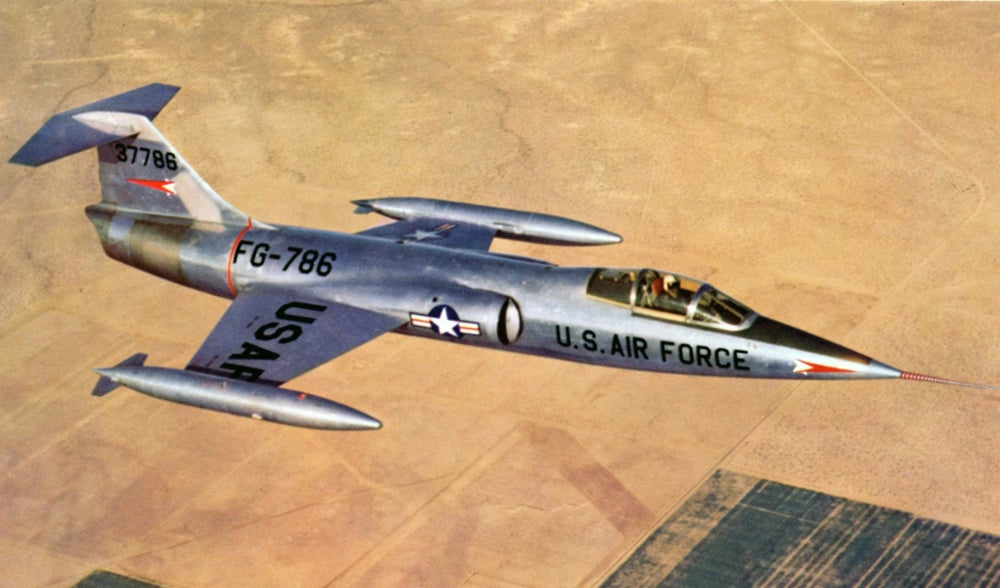
March 4, 1954 – The first flight of the Lockheed F-104 Starfighter. Most of the earliest jet fighters were built with the prevailing technology of WWII, and that meant straight wings. But when troves of data on the benefits of swept wings were captured from the Germans near the end of the war, the swept wing became a standard design element of jet fighters going forward. Delta wings, another design element pioneered by the Germans, were also adopted. But if anybody was going to buck that trend, it was Lockheed’s Clarence “Kelly” Johnson , perhaps America’s greatest aircraft engineer and one who became famous for doing things his way. During the Korean War, American pilots came face to face with smaller, more nimble Russian fighters like the MiG-15 . While the Americans ultimately prevailed, due in large part to better training and more experienced pilots, it was a much closer fight in the early part of the war. Johnson traveled to Korea in 1951 to interview US pilots and asked them directly what they wanted to see in a new fighter. Most said they wanted something smaller, faster, and more maneuverable. So Johnson, never one to do things in half measures, envisioned a very small fighter wrapped tightly around a single powerful engine that could race at Mach 2 in level flight. For the all important wings, Johnson eschewed the traditional swept or delta wings in favor of minimal, trapezoidal wings that bore a striking resemblance to the wings on the experimental Lockheed X-7 missile under development at the time. Johnson also gave the wings a slight anhedral, or downward angle, to help counteract potentially deadly inertia coupling , and high-pressure air was was also blown over the flaps on landing to help decrease landing speeds. Where the wings of contemporary aircraft were used to house fuel or landing gear, the wings of the Starfighter were razor thin, so thin in fact that the leading edges were covered with a felt cap to protect the ground crews who serviced the fighter. But not all of Johnson’s ideas were winners. Early models were given a downward-firing ejection seat over concerns that pilots would not clear the T-tail, though this questionable arrangement was changed to a standard upward firing ejection seat in subsequent models. The Starfighter moved from contract to first flight in less than one year, but development of the new fighter proved difficult, and it was four years before the first Starfighters entered service with the USAF. Then, just three months later, all F-104s were grounded because of engine problems and a series of accidents. The F-104A also suffered from a lack of all-weather capability and short range, and after only one year of frontline Air Force service, the A model was passed to units of the Air National Guard or used as a QF-104 target drone. Lockheed followed up with the F-104C, which added an improved fire control radar and capacity for more ordnance, and the Air Force sent the Starfighter to Vietnam. Though it served two tours, F-104 pilots claimed no enemy kills while losing 14 of their own aircraft in the process. By this time, the Air Force had lost interest in the Starfighter, and that could have been the end of the road for Johnson’s innovative little fighter.
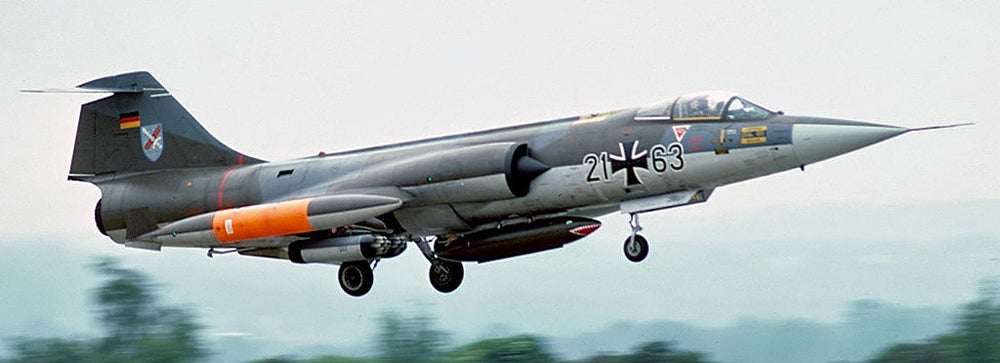
But in 1959, a group of allied countries led by Germany decided to procure the F-104 as a multi-mission attack fighter to replace older jet aircraft in service, though accusations Lockheed bribed the European officials to accept the Starfighter dogged the decision. The F-104G (G for Germany) was built under license by Canadair and by a consortium of European companies including Messerschmitt / MBB , Dornier, Fiat , Fokker , and SABCA . Dubbed the Super Starfighter, it had a strengthened fuselage and wing, increased fuel capacity, enlarged fin and redesigned flaps for combat maneuvering. And, unlike the original F-104 which sacrificed a fire control radar to save space and weight, the F-104G was fitted with a radar as well as an inertial navigation system, the first on any production fighter. Thus, the F-104G made up the bulk of all Starfighters produced, with 1,122 out of a total of 2,578 built by the European consortium. Though the US Air Force was done with the Starfighter by 1969, but it would serve in Europe for another ten years, with the final aircraft, the Aeritalia F-104S, serving until 2004. (US Air Force photo; photo by Mike Freer via Wikimedia Commons )
!!! UNKNOWN CONTENT TYPE !!!

March 4, 1936 – The first flight of the Hindenburg (LZ 129). Though the airplane gets much of the credit for helping mankind slip the surly bonds of earth, it was a balloon that first took men into the air on November 21, 1783, when the Montgolfier brothers flew their hot air balloon over France. Less than two months later, Jacques Charles and the Robert Brothers , again in France, flew the world’s first hydrogen balloon, not only ascending to a then unheard of altitude of 3,000 meters, but also carrying aloft instruments to measure temperature and barometric pressure. By 1785, a hydrogen balloon made the first flight across the English Channel, and in 1852 the first powered and steerable dirigible took to the skies in France. This semi-rigid airship paved the way for huge airships with metal frames housing bags of hydrogen or helium, culminating with the Hindenburg , the largest aircraft ever built. The first Zeppelin, a rigid airship named after its creator, German Count Ferdinand von Zeppelin , entered commercial service in 1910. Eventually, Zeppelins became the world’s first airliners, and transatlantic flights became commonplace. The Hindenburg , German dirigible LZ-129 ( Luftschiff Zeppelin #129, registration D-LZ129) was the lead ship of the Hindenburg class. Designed and built by the Zeppelin Company ( Luftschiffbau Zeppelin GmbH ) and named after the late Field Marshal Paul von Hindenburg , the President of Germany from 1925-1934, Hindenburg was constructed of a duralumin framework and fitted with 16 cotton gas bags. The outer skin of the dirigible was made of cotton and doped with a reflective coating to protect the gas bags from ultraviolet and infrared radiation. With enormous swastikas painted in the tail fins, the gigantic Hindenburg was as much an object of Nazi propaganda as it was a transatlantic passenger vessel. Hindenburg was originally built to be filled with helium, but helium was rare and came at an exorbitant cost. Construction of the Hindenburg went ahead regardless, even though the designers knew they would have trouble obtaining helium from the United States, where it was a byproduct of natural gas mining. When the US refused to lift the export ban on helium, Hindenburg’s designers made the fateful decision to switch to highly flammable hydrogen instead, even though the dangers of hydrogen were well known. Hindenburg’s first commercial flight took place on March 31, 1935, and the Zeppelin made 17 round trips across the Atlantic beginning with a trip to Lakehurst, New Jersey on May 6, 1936. In July of that year, it made a record double crossing of the Atlantic in just under 6 days. Despite its unparalleled speed and size, Hindenburg would become most famous for the devastating crash that marked its final flight.
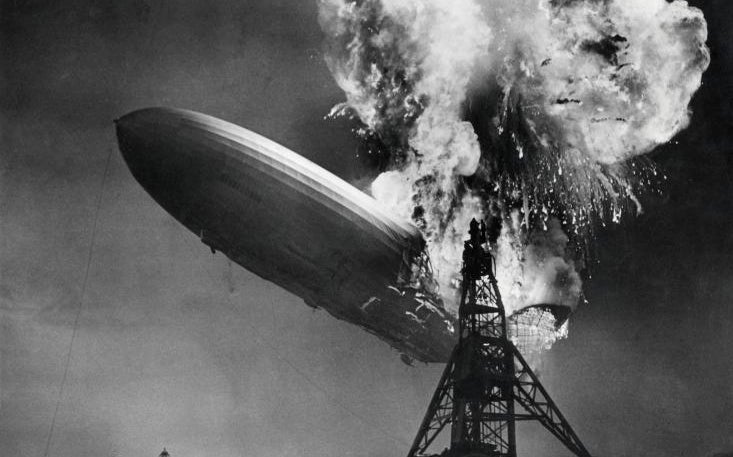
Hindenburg left Frankfurt on May 6, 1937 on a transatlantic crossing to Lakehurst. It’s arrival was initially delayed by a line of thunderstorms, but Hindenburg was finally cleared to land at about 7:00 pm. Twenty-one minutes later, shortly after dropping mooring lines to the ground crew, Hindenburg suddenly erupted into flames and crashed, and in less than thirty seconds the massive Zeppelin was reduced to a smoldering wreck of twisted, charred metal. Thirteen of the 36 passengers died, along with 22 of the crew of 61 and 1 man on the ground. The cause of the crash remains a topic of much conjecture even to this day, and no exact cause has ever been determined. Some suspect sabotage, others suggest atmospheric conditions related to the thunderstorms in the area. One of the more plausible theories is that hydrogen gas leaking from one of the cells was ignited by static electricity. After the crash, the duralumin hulk was returned to Germany and recycled for use in the construction of Luftwaffe aircraft. Graf Zeppelin II (LZ 130) , Hindenburg’s sister ship and the last great Zeppelin built by Germany, was scrapped in 1940 before its completion, and its duralumin frame was also melted down for the construction of warplanes. (Associated Press photo via Wikimedia Commons; photo by Sam Shere via Wikimedia Commons )
!!! UNKNOWN CONTENT TYPE !!!
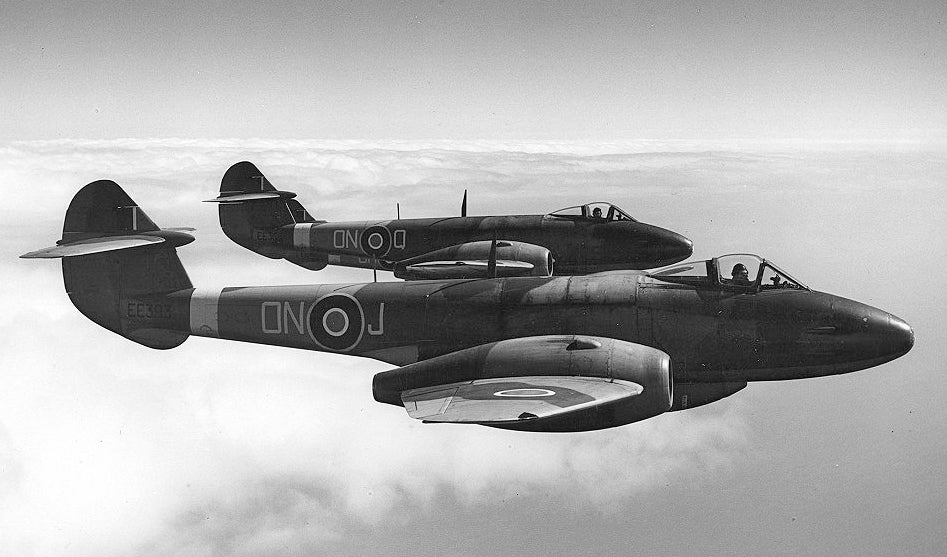
March 5, 1943 – The first flight of the Gloster Meteor. The history of aviation is a tale of extraordinarily rapid development in technology, with each new aircraft taking an incremental forward step from those that came before it, more often than not in a quest for greater speed. When the Wright Brothers first flew at Kitty Hawk, their Flyer managed a mere 6 mph across the ground, and it wasn’t long before advances in engine technology and aircraft construction saw speeds increase into the hundreds of miles per hour. But there was a limit to just how fast a propeller plane could fly, and by WWII, that limit was being reached. The invention of the turbojet engine broke that barrier once and for all, and the story of the Gloster Meteor is inextricably linked to the story of the jet engine. While the development of the turbojet engine is often associated with WWII, its origins can be traced back to well before the war began. Royal Air Force engineer Sir Frank Whittle had been working on the principle of a motorjet , where a traditional piston engine is used to drive a compressor. Whittle’s breakthrough came when he thought of replacing the piston engine of the motorjet with a turbine, and he patented his first design in 1930. By 1936, he had formed his own company, Power Jets Ltd , to continue work on his concepts. Though he found it difficult to find financial backers for his project, and hard to find anybody to build a plane to put the new engine in, Whittle eventually visited the Gloster Aircraft Company in 1939. There he met Gloster’s chief engineer, George Carter , who took an interest in Whittle’s new engine and began work on an aircraft design in which to implement the turbojet. The first proof of concept aircraft was the Gloster E.28/39 , a single-engine aircraft that took its maiden flight on May 15, 1941. With proof that the turbojet worked, Gloster moved ahead with work on a production fighter, but decided to use two engines to make up for the lack of power in the early turbojet. By 1940, Carter had the first proposal for the twin-engine Meteor fighter, and within 6 months Gloster received an order for 8 prototypes under Specification F9/40, which was written to match the fighter already in development. The Meteor was built in a modular fashion consisting of five main sections: nose, forward fuselage, central section, rear fuselage, and tail sections. Various companies were contracted to build modules, and this modular concept allowed production to be dispersed. It also facilitated disassembly and transport of the Meteor. The Meteor was introduced on July 27 1944, with the first aircraft delivered to No. 616 Squadron of the RAF. With a top speed of 600 mph, 100 mph faster than the Supermarine Spitfire , the Meteor was first flown against the German V-1 flying bombs that were terrorizing England. On August 4, 1944, Meteor pilots claimed their first kills when they shot down 2 V-1s, and they would eventually claim 14 “buzz bombs” by the end of the war. Initially, Meteors were forbidden from flying over German-held territory for fear that one of the fighters would fall into enemy hands. But when the V-1 threat subsided, Meteors finally were finally sent to Europe in January of 1945, but the clash between the Meteor and the Messerschmitt Me 262 , Germany’s first operational jet fighter, never occurred.
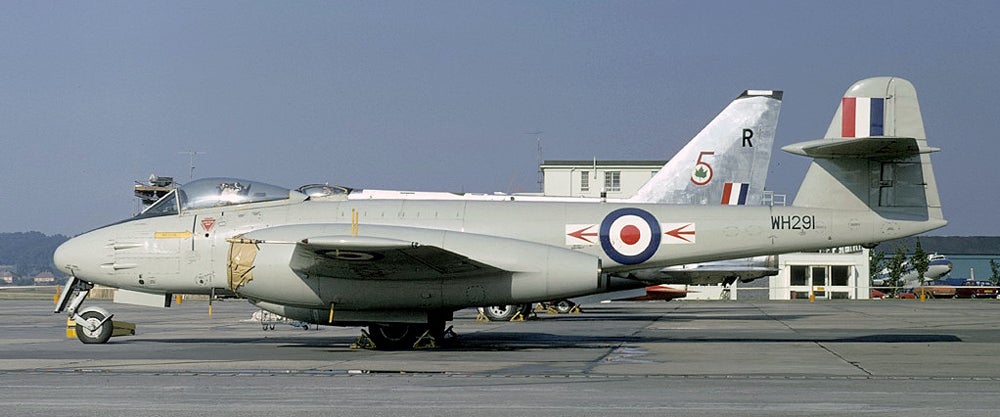
Production and development of the Meteor continued after the war, with improvements made in the design, fuel capacity, radar and weapons systems, as well as a two-seat trainer version. F8 Meteors flying with the Royal Australian Air Force saw significant action during the Korean War. Nearly 4,000 Meteors were built by the time production ended in 1955, and they were widely exported. British Meteors ended their days with the RAF as target tugs, flying into the 1980s. Despite their retirement, Meteors are still providing useful service today. The Martin-Baker Aircraft Company , pioneers in ejection seat technology, still flies a pair of Meteors to perform flight tests of the latest ejection seats. (UK Government photo; photo by Mike Freer via Wikimedia Commons )
!!! UNKNOWN CONTENT TYPE !!!

March 5, 1936 – The first flight of the Supermarine Spitfire. The period between World War I and World War II is known as the Golden Age of Aviation , a time when rapid advances were made in aircraft design and technology. Air races were a world phenomenon, and many of the advances in speed and aerodynamic design were made in the interest of winning trophies and prize purses. By the mid-1930s, with the prospect of war looming in Europe, the Royal Air Force needed to develop a new fighter that could intercept and defeat faster, more advanced German aircraft. Supermarine had made a name for itself building racing seaplanes, and had won the prestigious Schneider Trophy three times between 1927-1931. Using experience from their racing days, Supermarine developed the Type 300, which underwent significant subsequent development to include an enclosed cockpit, retractable landing gear, smaller wings, and an oxygen supply for the pilot. Supermarine designer R. J. Mitchell also gave the Spitfire one of its most recognizable features: its graceful elliptical wing, with an exceptionally thin cross section that helped increase the Spitfire’s top speed. But most importantly, they settled on the Rolls-Royce PV-12 engine, the precursor to the mighty Merlin . The Spitfire was an immediate winner. Upon landing after the first flight of the prototype, Vickers chief test pilot Capt. Joseph “Mutt” Summers reportedly said, “Don’t touch anything.”
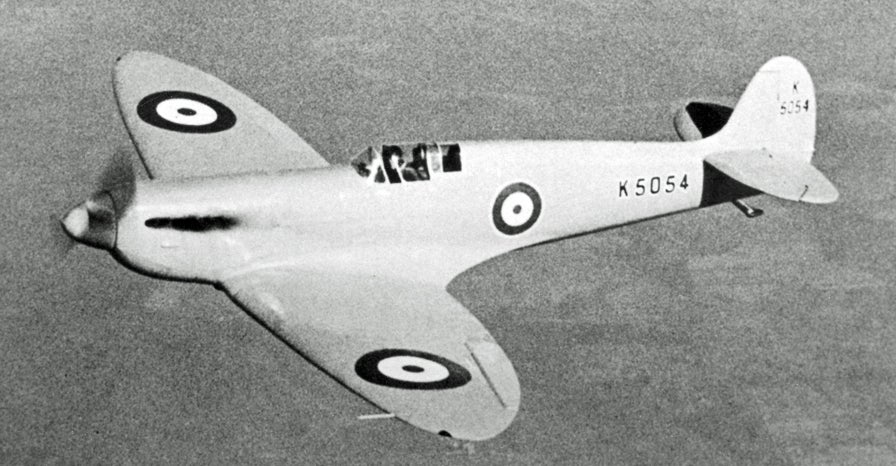
Though the Spitfire would become synonymous with the Merlin engine, it was not without its teething problems. Unlike the fuel injected engines in use by the Luftwaffe, the Merlin had a carburetor. This made the Spitfire susceptible to flooding in a nose-over dive or inverted flight. At first, pilots learned to combat this problem by first half-rolling the aircraft before a dive. But until a permanent solution could be found with the addition of a pressurized carburetor, it was Beatrice “Tilly” Shilling who saved the day. Shilling devised a restrictor, nicknamed Miss Shilling’s Orifice , that restricted the flow of fuel to no more than the engine could use at full power. While only a stopgap measure, the restrictor kept the Spitfire flying until the new carburetors could be developed. With the last round of Spitfire production, the Merlin gave way to the Rolls-Royce Griffon which employed a pressure-injection carburetor and boasted 2,340 hp and a top speed of nearly 500 mph. During the Battle of Britain , the Spitfire, along with the Hawker Hurricane , faced the onslaught of the Luftwaffe. Though the less glamorous Hurricane fought in greater numbers, the Spitfire became the better known fighter of the battle, as dashing RAF fighter pilots dueled with German fighters high in the sky while the “Hurrys,” which were no match for the Messerschmitt Bf 109 , slugged it out with the bombers at lower altitudes. Head to head with the 109, the Spitfire pilot appreciated the firepower provided by its eight Browning .303 machine guns. While not as powerful as the canon used by the Germans, Spitfire pilots could concentrate more firepower on the enemy. The Spitfire was continuously improved and was produced throughout the war. Numerous variants were developed, including a carrier-based version which was nicknamed the Seafire , and export Spitfires were flown by 35 countries around the world. The mission of the Spitfire didn’t end with VE Day . They continued patrolling German skies after the war, and Spitfires flew over 1,800 sorties during the Malayan Emergency , and the final operational sortie flown by the Spitfire took place on April 1, 1954. In all, more than 20,000 Spitfires were produced from 1938-1948, making it the third-highest produced warplane behind the Ilyushin Il-2 Sturmovik (36,183) and the Bf 109 (34,852). (Photo by RHL Images via Wikimedia Commons ; photo author unknown)
!!! UNKNOWN CONTENT TYPE !!!
!!! UNKNOWN CONTENT TYPE !!!
!!! UNKNOWN CONTENT TYPE !!!
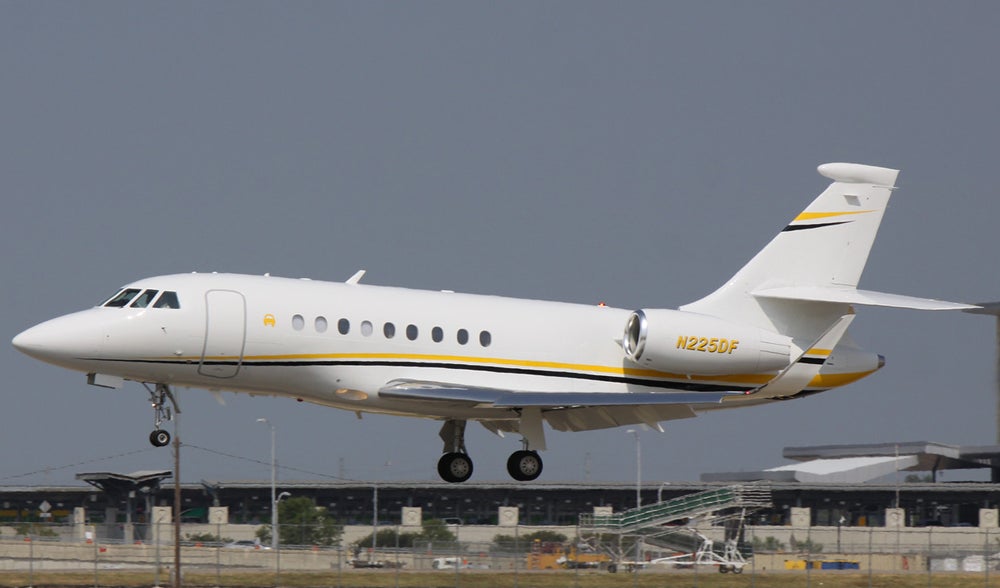
March 4, 1993 – The first flight of the Dassault Falcon 2000,
a business jet made by the French company
Dassault Aviation
and a smaller development of the
Dassault Falcon 900
. Where the 900 is a trijet, the 2000 has only two engines, yet it is still capable of intercontinental range. Continued development of the 2000 has brought extended range, short runway capability and increased fuel efficiency. Dassault has also proposed a maritime reconnaissance version, and the 2000 is currently operated by the militaries of France, Bulgaria, Slovenia and the Republic of Korea. Powered by 2
Pratt & Whitney PW308C
turbofans, the 2000 is capable of speeds of Mach 0.85 with a range of up to 6,000 nautical miles.
(Photo by the author)
!!! UNKNOWN CONTENT TYPE !!!
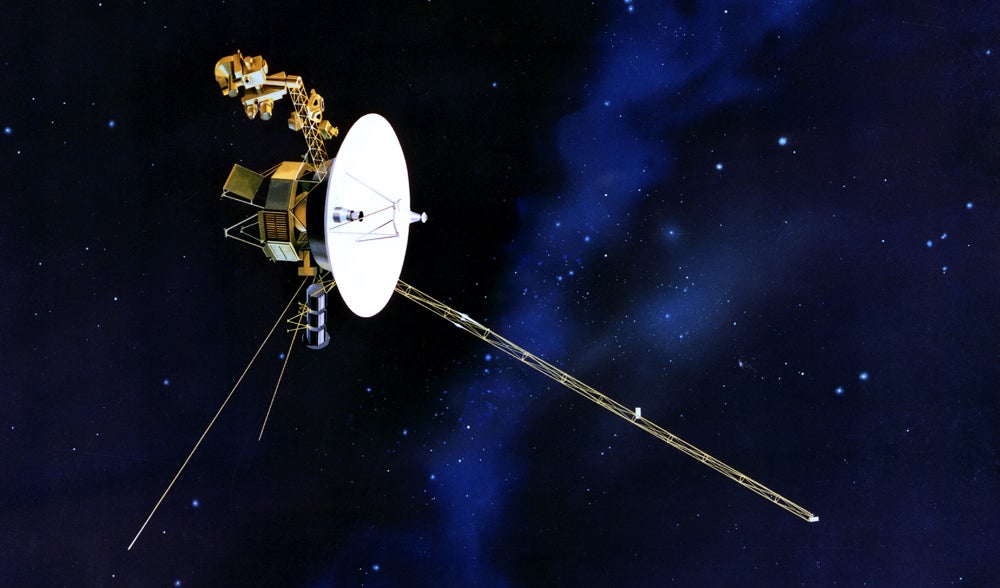
March 5, 1979 – Voyager 1 makes its closest approach to Jupiter. Voyager 1 was launched on September 5, 1977 on a mission to study the outer solar system. Launched 16 days after Voyager 2 , Voyager 1 has operated for more than 38 years and continues to return data to Earth. After close flybys of Jupiter, Saturn and Saturn’s moon Titan, Voyager 1 continued to the boundaries of the outer heliosphere and, on August 25, 2012, it became the first spacecraft to enter interstellar space. Voyager will continue functioning until its batteries run out in 2025. (NASA/JPL illustration)
!!! UNKNOWN CONTENT TYPE !!!

March 5, 1963 – A plane crash claims the life of country music singer Patsy Cline. Following a benefit concert in Kansas City, Kansas, Cline was unable to leave following the show because the local airport was fogged in. She passed on an offer of a car ride to Nashville, opting instead to fly out the next day. On the day of the crash, she boarded a Piper PA-24 Comanche (N-7000P) for the flight to Nashville. After a stop for fuel in Dyersburg, Tennessee, the pilot chose to continue despite worsening weather, even though he was not qualified for instrument flying ( IFR ). Cline’s plane crashed 90 miles from Nashville, and the NTSB report cited the cause as the pilot’s loss of control in adverse conditions. Along with Cline, musicians Hawkshaw Hawkins , Cowboy Copas , and pilot Randy Hughes were killed. (Cline photo by Four Star Records via Wikimedia Commons ; Piper PA-24 photo, not crash aircraft, by Alan Radecki via Wikimedia Commons )
!!! UNKNOWN CONTENT TYPE !!!
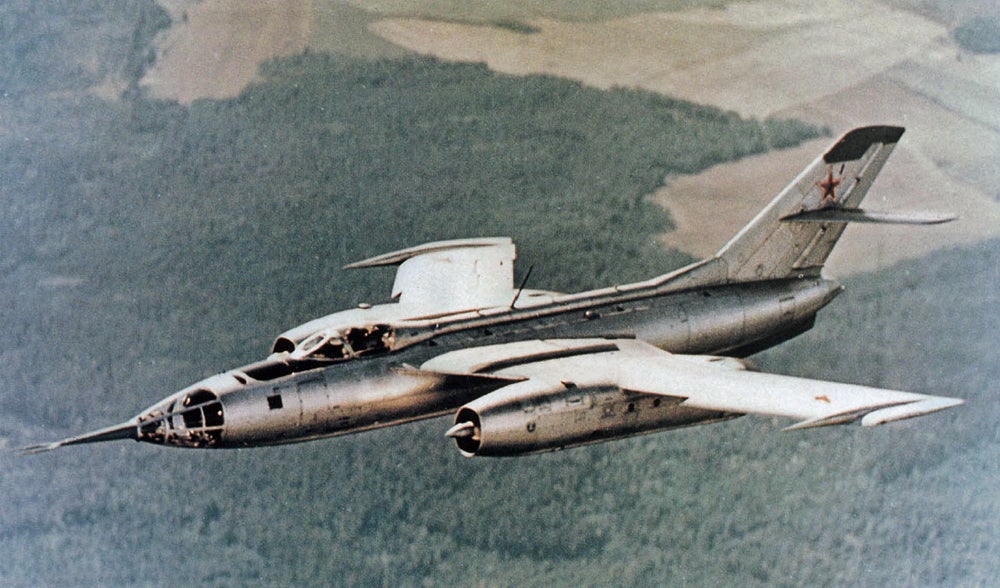
March 5, 1958 – The first flight of the Yakovlev Yak-28, a Cold War era tactical bomber produced by the Soviet Union. The Yak-28 was powered by two Tumansky R-11 afterburning turbojets mounted in pods beneath 45-degree swept wings. Though designed as a tactical bomber, the Yak-28 was also used for reconnaissance, electronic warfare, as an interceptor, and as a trainer, and its NATO reporting names —Brewer (bomber), Firebar (fighter), Maestro (miscellaneous)—reflected the mission of the particular variant. It had a top speed of 735 mph and was armed with 1 or 2 30mm cannons and up to 4,410 pounds of bombs and missiles. The Yak-28 was introduced in 1960, and served the Soviet Union, Russia, Turkmenistan and Ukraine. Nearly 1,800 were produced. (Photo author unknown)
!!! UNKNOWN CONTENT TYPE !!!
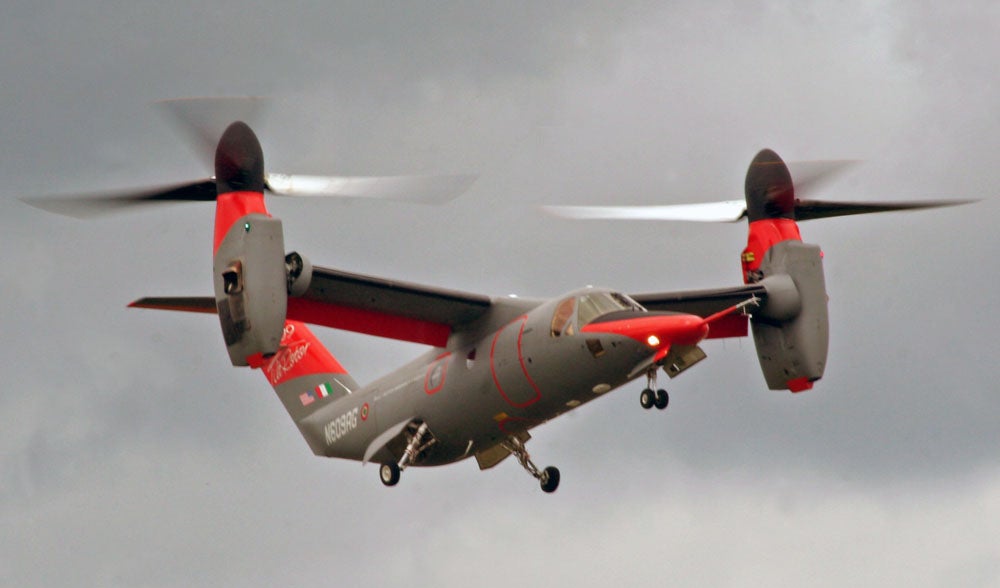
March 6, 2003 – The first flight of the AgustaWestland AW609, a twin-engine tiltrotor VTOL aircraft being developed for the civilian market. Similar to the Boeing V-22 Osprey , the AW609 is capable of vertical takeoff and landing, with transition to forward flight provided by turboprop engines mounted in swiveling nacelles on the end of the wings. AgustaWestland plans to market the AW609 to VIP customers and the offshore oil and gas industry. Development was slowed after the crash of the second prototype in October 2015 which killed two test pilots. For still unknown reasons, the aircraft broke up in midair during high speed testing. The AW609 is still awaiting certification, and AgustaWestland is considering a site in the US for production. (Photo by pjs2005 via Wikimedia Commons )
!!! UNKNOWN CONTENT TYPE !!!
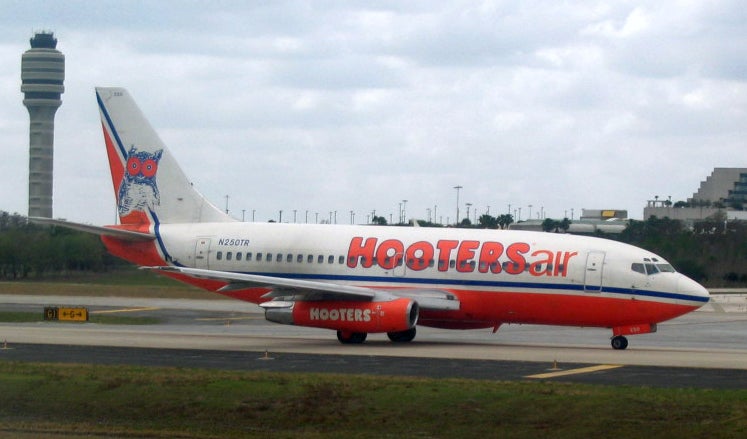
March 6, 2003 – The launch of Hooters Air. Hooters Air was founded by Robert Brooks, the owner of Hooters of America, a restaurant perhaps best known for the revealing attire worn by its waitresses. Brooks acquired Pace Airlines in 2002, and rebranded the jets in Hooters Air livery. The airline focused on the golfing set, hoping to drum up business with passengers, presumably men, who wanted to take flyaway golf trips. Each flight was staffed by two Hooters waitresses in the regular Hooters attire in addition to a standard complement of flight attendants who wore traditional uniforms. Faced with increased fuel costs following Hurricanes Rita and Katrina, Hooters Air ceased operations on April 17, 2006 after an estimated cost of $40 million spent on the venture. (Public domain photograph)
!!! UNKNOWN CONTENT TYPE !!!
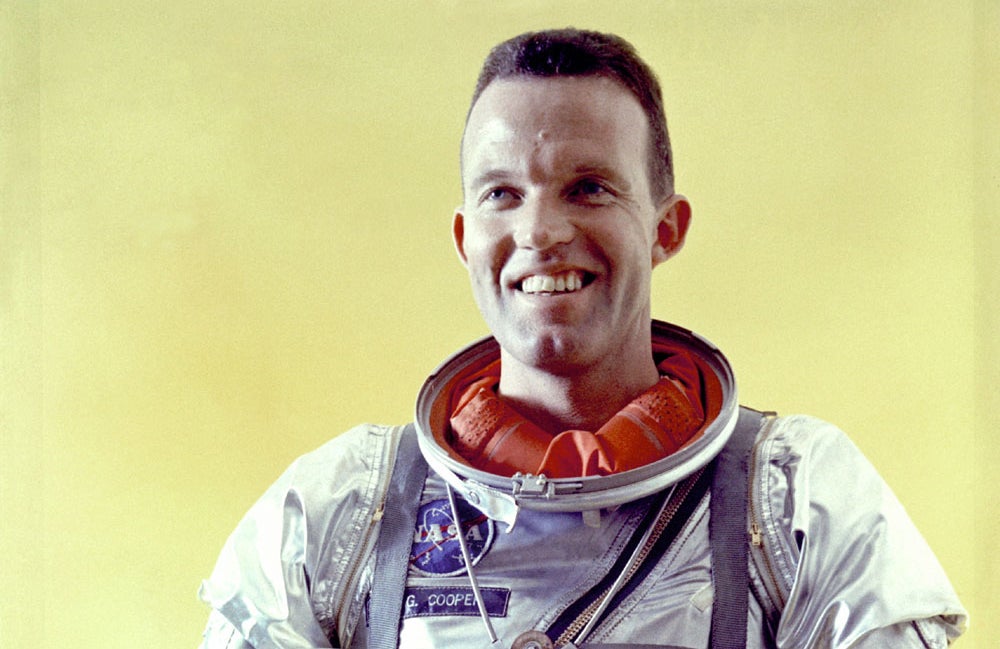
March 6, 1927 – The birth of US astronaut Gordon Cooper. Born in Shawnee, Oklahoma, Leroy Gordon “Gordo” Cooper was an engineer, test pilot, US Air Force pilot, and one of the Mercury Seven , the original seven astronauts who took part in Project Mercury , NASA’s first manned space program and precursor to the Gemini and Apollo programs. On the final Mercury mission in 1963, Cooper piloted his Faith 7 capsule on the longest flight of the Mercury program, and was the first American to sleep in space. He was also the last American astronaut launched into space on a solo orbital mission. Cooper also flew as Command Pilot of Gemini 5 in 1965, a flight that set the first record for American duration in space for the time. Cooper died on October 4, 2004 in Ventura, California at age 77. (NASA photo)
!!! UNKNOWN CONTENT TYPE !!!
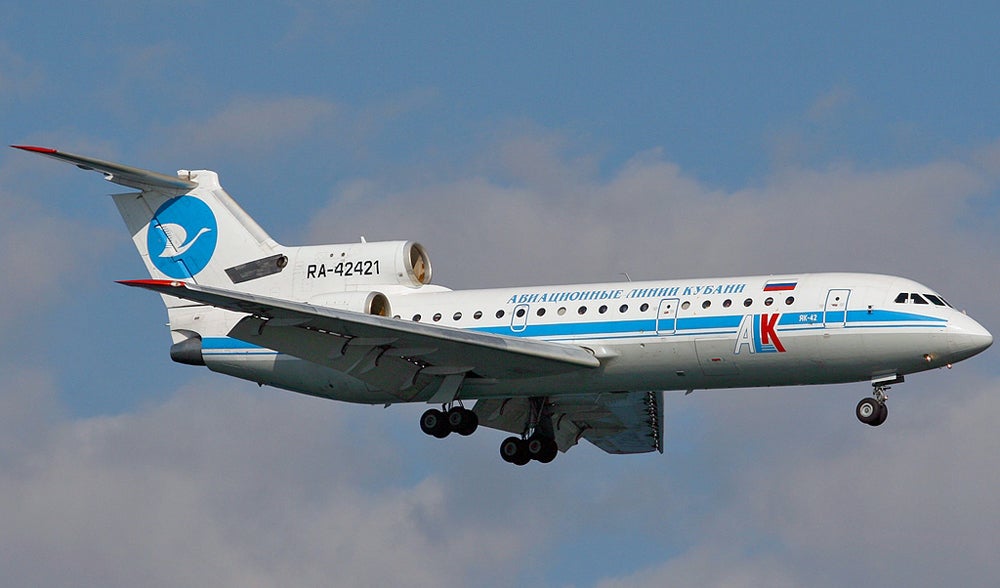
March 7, 1975 – The first flight of the Yakovlev Yak-42, a medium-range trijet airliner and the first Soviet airliner to be powered by high-bypass turbofan engines. Developed from the Yakovlov Yak-40 , the world’s first commuter trijet, the Yak-42 was primarily intended as a replacement for the Tupolev Tu-134 , as well as other older turboprop-powered airliners. The airliner is powered by three Lotarev D-36 high bypass turbofans, has a cursing speed of 460 mph with a maximum range of 2,458 miles, and can accommodate up to 120 passengers. The Yak-24 entered service with Aeroflot in December 1980, and it remains in service, flying primarily on routes out of Moscow, with some international service to Helsinki and Prague. The Yak-42 was produced from 1979-2003, and a total of 140 were built. (Photo by Konstantin von Wedelstaedt via Wikimedia Commons )
!!! UNKNOWN CONTENT TYPE !!!
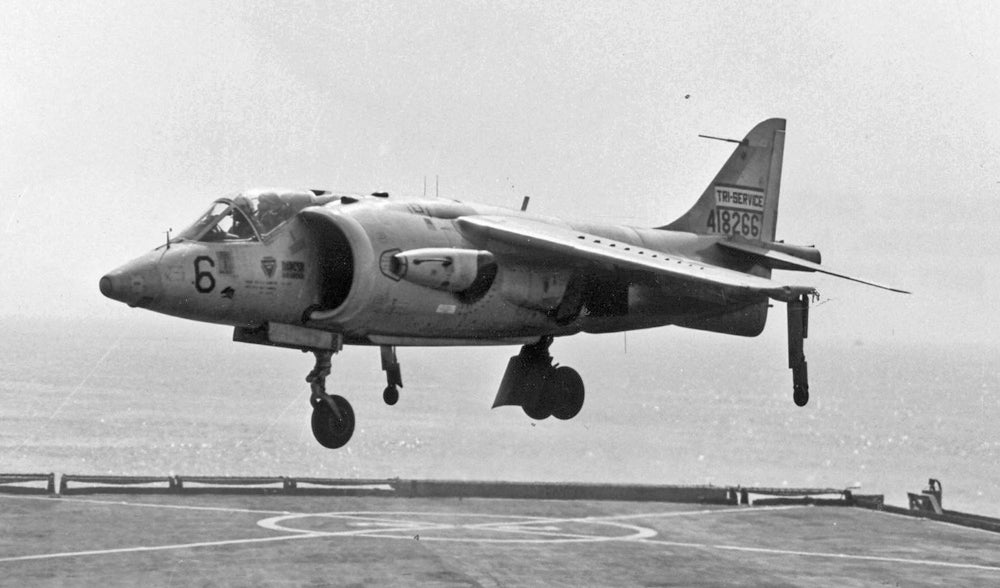
March 7, 1964 – The first flight of the Hawker Siddeley Kestrel. The Kestrel was the second experimental aircraft, following the Hawker P.1127 , that explored vertical/short take-off and landing (V/STOL) and led to the development of the Hawker Siddeley Harrier . Development of both the P.1227 and Kestrel began in 1957 following the introduction of the Rolls-Royce Pegasus vectored-thrust engine. The Kestrel (FGA.1) was an improved version of the P.1227, with fully swept wings, larger tail, and enlarged fuselage to accommodate the larger Pegasus 5 engine. Nine Kestrels were built and flown by the Tripartite Evaluation Squadron comprised of pilots from England, Germany and the United States (where it was known as the XV-6A). Ultimately, the Kestrel would become the prototype for pre-production Harriers. (US Navy photo)
!!! UNKNOWN CONTENT TYPE !!!
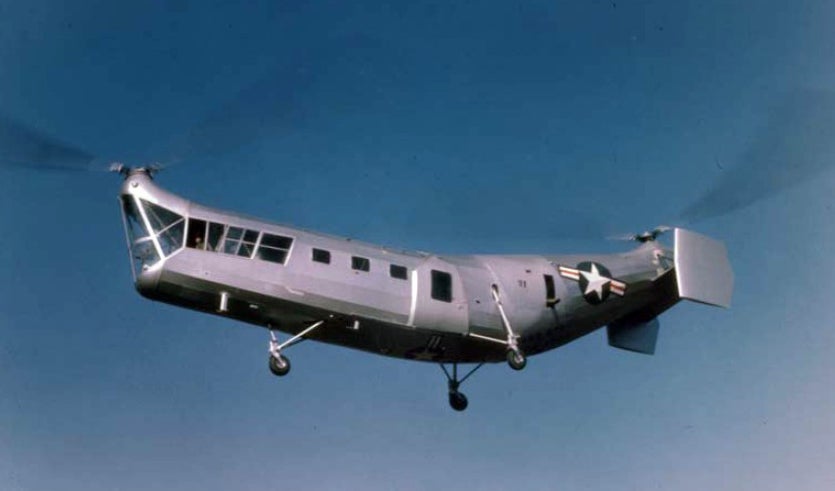
March 7, 1945 – The first flight of the Piasecki HRP Rescuer, a tandem rotor helicopter designed by Frank Piasecki , a pioneer in the development of tandem rotor helicopters. To keep the two rotors from colliding, the rear of the fuselage curved upward, giving the Rescuer the nickname “Flying Banana.” It featured a tricycle landing gear, and the fuselage was built of steel tubing covered with doped fabric. The Rescuer was the first US military helicopter with the capacity for a significant number of passengers, and it served the US Navy, Marine Corps and Coast Guard as a transport and cargo helicopter and for air-sea rescue. Piasecki built 28 Rescuers, and it was later developed into the H-21 Shawnee which served in Korea and Vietnam. (US Coast Guard photo)
!!! UNKNOWN CONTENT TYPE !!!
!!! UNKNOWN CONTENT TYPE !!!
!!! UNKNOWN CONTENT TYPE !!!
!!! UNKNOWN CONTENT TYPE !!!
!!! UNKNOWN CONTENT TYPE !!!
!!! UNKNOWN CONTENT TYPE !!!
!!! UNKNOWN CONTENT TYPE !!!
If you enjoy these Aviation History posts, please let me know in the comments. And if you missed any of the past articles, you can find them all at Planelopnik History . You can also find more stories about aviation and aviators at Wingspan and Planes You’ve (Probably) Never Heard Of .
!!! UNKNOWN CONTENT TYPE !!!
 "S65" (granthp)
"S65" (granthp)
03/07/2017 at 12:42, STARS: 0
Cool! Also I thought you were done with these
 "ttyymmnn" (ttyymmnn)
"ttyymmnn" (ttyymmnn)
03/07/2017 at 12:45, STARS: 0
I was. But once my audition was over (I got the job), I felt compelled to pick it up again after about 6 weeks.
 "AfromanGTO" (afromangto)
"AfromanGTO" (afromangto)
03/07/2017 at 12:48, STARS: 1
Good read!
 "ttyymmnn" (ttyymmnn)
"ttyymmnn" (ttyymmnn)
03/07/2017 at 12:58, STARS: 1
Thanks! And thanks for reading.
 "MrDakka" (mrdakka)
"MrDakka" (mrdakka)
03/08/2017 at 13:50, STARS: 2
Starfighter is best fighter XD